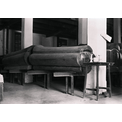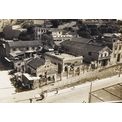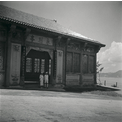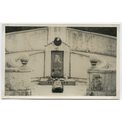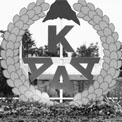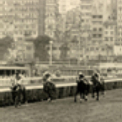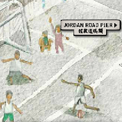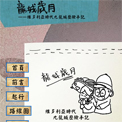 Collections
Collections Hong Kong, Benevolent City: Tung Wah and the Growth of Chinese Communities
Hong Kong, Benevolent City: Tung Wah and the Growth of Chinese Communities History of Tung Wah Services
History of Tung Wah Services Tung Wah's Repatriation of Remains Service for Overseas Chinese
Tung Wah's Repatriation of Remains Service for Overseas Chinese
1. Immigrant Society, the Coolie Trade and Chinese Burial Practices
After the Anglo-Chinese Opium War, Hong Kong became a free port. The city’s flourishing entrepôt trade attracted a huge foreign population composed of overseas merchants, missionaries, adventurers and Chinese who came to earn a living. In the early days, the Hong Kong Government built the Wan Chai Catholic and Hong Kong (Happy Valley) cemeteries for the burial of foreigners who had passed away in Hong Kong. The majority of Chinese people, however, could not afford funeral expenses and would normally be buried hastily on a hillside or on a deserted patch of land. Many of these latter graves were quite close to residential areas and posed serious threats toward maintaining minimum levels of environmental hygiene. Only in 1856 did the government build two cemeteries for the Chinese. Unclaimed remains, however, continued to be found during the construction work that followed all over the city. All remains found in this way were buried in the Slaughter House Cemetery.
At that time, Hong Kong was an important transportation hub for Chinese labourers travelling to foreign countries. It was also through Hong Kong that the remains of deceased overseas Chinese labourers would pass on their way home to their final resting place. News reports date remains of deceased Chinese being repatriated from overseas through Hong Kong as early as 1855. Against this backdrop, coffin homes and coffin vessels emerged to temporarily store the coffins in transit. As the number of overseas Chinese labourers increased, instances of bone repatriation surged.
2. Tung Wah Burial Services
Bodily remains were unearthed during the construction of the Tung Wah Hospital in the Tai Ping Shan District. These remains were buried next to the slaughter house in Kennedy Town marking the start of Tung Wah’s provision of burial services. Later, Tung Wah placed coffins on passenger vessels to the United States as a means of holding the remains of passengers who happened to die on board so as to ensure their remains would not be abandoned at sea. Unclaimed remains would then be transferred to Tung Wah for burial.
Tung Wah established several cemeteries as part of its charitable work. These included the Zou Fung Graveyard for victims of the typhoon of 1874, the Racecourse Fire Victims’ Cemetery (present-day Race Course Fire Memorial and Cemetery) for victims of the 1918 Racecourse Fire, and the Sai On Graveyard for victims of the blaze that destroyed the passenger vessel, Sai On, in 1947. Before the Second World War, the government would normally pass unclaimed remains to the Tung Wah Hospital for burial in the Slaughter House Cemetery. During the 1950s, and in line with urban development programmes, Tung Wah moved some remains from the Slaughter House Cemetery to the Sandy Ridge and Wo Hop Shek cemeteries. Today, the Tung Wah Group of Hospitals continues to provide reasonably priced funeral services to the general public and free services to underprivileged families through its subsidiaries, the International Funeral and Diamond Hill Funeral parlours.
The Man Mo Temple built the coffin home near the Slaughter House in 1875. It was soon taken over by the Tung Wah Hospital. In 1899, Tung Wah was granted a piece of land in Sandy Bay for the building of the Tung Wah Coffin Home. The facility not only provided temporary sanctuary for local Chinese after they had passed away, but was also the location where remains of overseas Chinese were kept before being transported to mainland China. Later, in 1974, after cremation became increasingly popular, the Tung Wah Coffin Home added a columbarium along with an urn depository service. The Coffin Home continues to provide coffin and urn depository services to this day.
3. Repatriation of Remains Service
In keeping with traditional practice, overseas Chinese wished to be revered by their descendants after death. Justified concerns regarding overseas burials included a fear that their graves would be vandalized by locals since racial discrimination was blatant and widespread. It fell upon overseas native organisations, therefore, to assist in arranging for the remains of overseas Chinese to be returned to China for burial. Before the Tung Wah Hospital was founded, remains were customarily received by representatives of mainland charities, town or village associations in Hong Kong. After the founding of Tung Wah, however, repatriation of remains for overseas Chinese was coordinated by the hospital and subject to regulations set down by the Hong Kong Government. Tung Wah did not charge any storage fees for remains that were kept temporarily in the coffin home. In fact, Tung Wah paid for advertisements to alert friends and family of the deceased or relevant charitable organisations, so that they might come forward and claim the remains. If remains went unclaimed for a long period of time, they would be interred by Tung Wah in the Slaughter House Cemetery.
The repatriation of remains service was suspended during the Japanese occupation of Hong Kong and then resumed after the end of hostilities. With the founding of the People's Republic of China in 1949, political changes in the mainland coupled with the trade embargo imposed by the United Nations on China made it impossible to transport coffins to China for a prolonged period of time. As a result, Tung Wah’s bone repatriation service ceased.
4. The Role of Repatriation of Remains in the Global Network
Overseas organisations and agents involved in services dedicated to the repatriation of remains span five continents and include among them Guangdong Dunshan Tang in Kobe, Japan, and the Xianjing Guangzhao Association of Thailand in Asia; the Chee Kung Tong of San Francisco, the Taishan Ningyang Association of Los Angeles and the Chinese Consolidated Benevolent Association of New York in North America; the Casino Chino Chung Wah of Havana, Cuba, the Sanyi Tongshantang of Panama and Tonghuy Chongkoc of Peru in South America; the Sze Yup Society of Sydney and the Sydney Zhengbu Tongshantang in Oceania; the Chinese Association in Tahiti as well as agents in Europe and Africa. Hundreds of overseas organisations have maintained connections with Tung Wah.
Over the years, the Tung Wah Coffin Home has mediated between relevant organisations in Hong Kong and the mainland. In Hong Kong, organisations involved in claiming skeletal remains include native associations, shantang (charitable organizations), commercial organisations and business enterprises. Some examples include the Toi Shan Association, Fung Toy Hall and the Wing On Company. The Tung Wah Hospital would also customarily inform mainland organisations such as shantang, village organisations and fangbian hospitals of the remains that had been received. Mainland organisations working with Tung Wah were mostly located in Guangdong province. Together they operated a coffin receiving network comprising over 40 locations. By collaborating to provide repatriation of remains services, these local and overseas organisations came together and formed a global charitable network reaching every corner of the planet, with the Tung Wah Hospital at its nexus.
